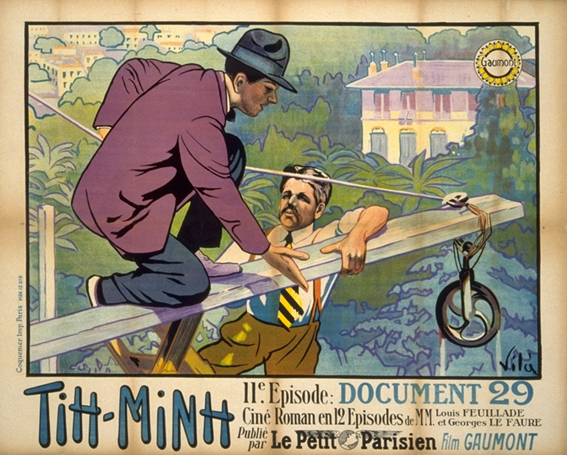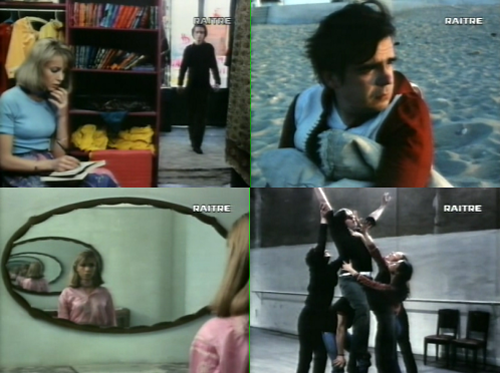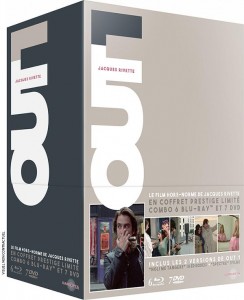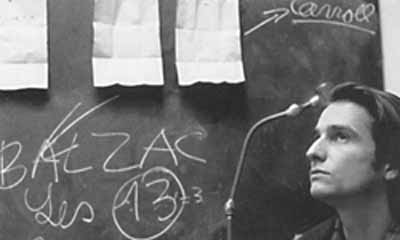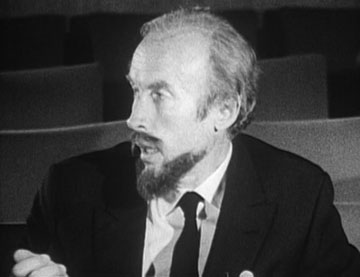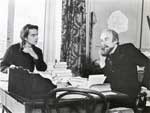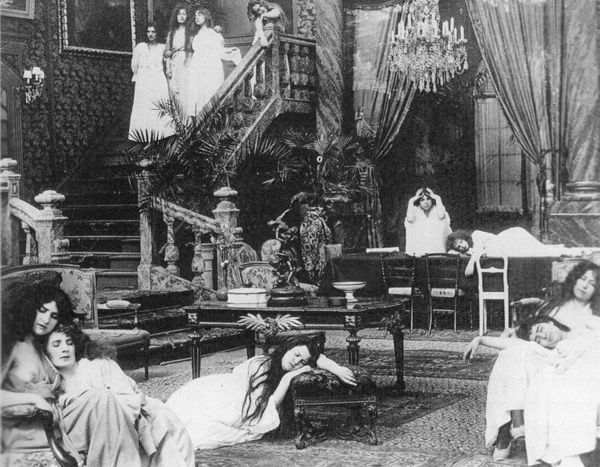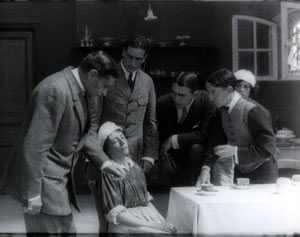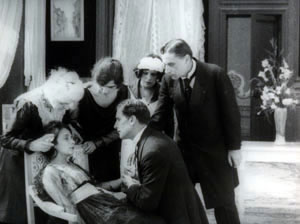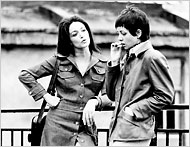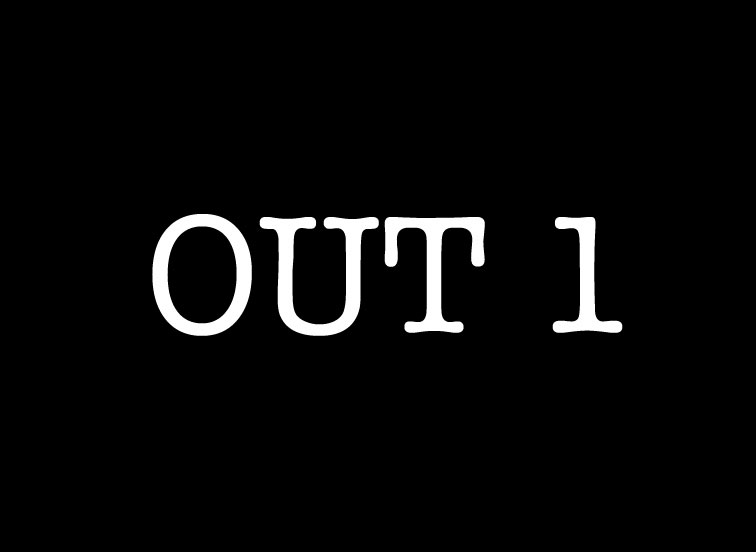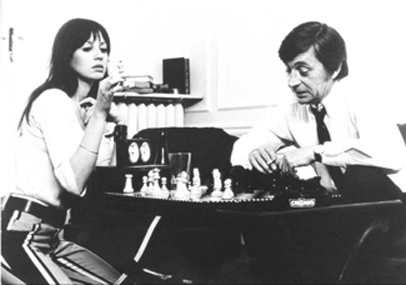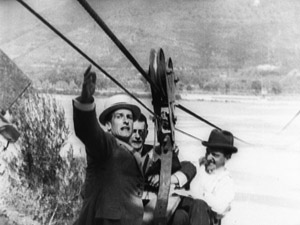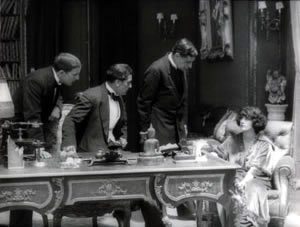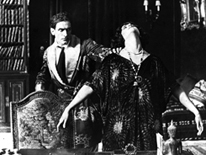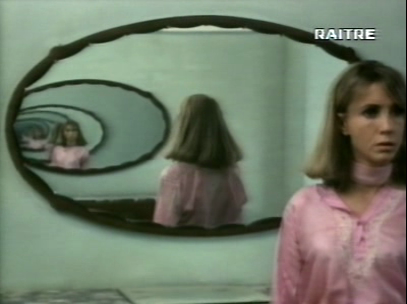From The Velvet Light Trap, spring 1996 (and reprinted in my 1997 collection Movies as Politics). Given all the screenings of Out 1 that have more recently taken place on both sides of the Atlantic, with (almost) concurrent Blu-Ray and DVD releases in France, the U.K., and the U.S., this seems like a good time to repost this article. My still lengthier reflections can be found on the Carlotta digital releases in France and the U.S. — J.R.
On the Issue of Nonreception
What connections can be found between two French serials made almost half a century apart? Aside from the fact that both of them appear on my most recent “top ten” list (1), I’m equally concerned with the issue of why such pleasurable, evocative, enduring, multifaceted, and incontestably beautiful works should remain so resolutely marginal — unseen, unavailable, and virtually written out of most film histories except for occasional guest appearances as the vaguest of reference points. The problem isn’t simply an American or an academic one; although no print of either serial exists in the United States, it can’t be said that either film has received much attention in France either — or elsewhere, for that matter. (2) Yet both are major testaments to the joys of spontaneous filmmaking and the complex adventures these entail, for their viewers as well as for their makers.
Louis Feuillade’s seven-hour, twelve-episode Tih-Minh, shot on the Côte d’Azur in 1918, released in early 1919; first seen by me at the Museum of Modern Art in April 1969. Jacques Rivette’s nearly thirteen-hour, eight-episode Out 1, shot mainly in Paris in spring 1970, rejected by French state television, shown publicly only once (9-10 September 1971, Le Havre) as a workprint. First seen by me (in a finished print) at the Rotterdam Film Festival on 2-3 February 1989; finally shown as a serial on the Paris Première cable channel in the early 1990s, and recently released in France on video. (3)
Properly speaking, I’ve never seen either serial in its integral form or as a serial, which already suggests part of the problem in keeping such works alive and discussed: their implied mode of reception is no longer ours, and the same applies to their original status as texts. The seven-hour Tih-Minh that I saw in 1969, a version held by the Brussels Cinémathèque, is (or was) missing most or all of the film’s intertitles, but it runs an hour longer than the (mainly) intertitled version held by the Paris Cinémathèque, shown at the New York Film Festival in 1980 and seen by me more recently on video. When I saw Out 1 in 1989, about forty minutes of the soundtrack in the sixth episode were still unlocated; these have been subsequently found and restored, but prior to most or all of its post-Rotterdam showings, Rivette did further editing on the serial, altering the order of certain scenes and making a few deletions, which makes the final running time 750 minutes instead of 760, a shorter version that I’ve also had access to on video. (3)
Complicating the textual status of Out 1 still further is the 255-minute Out 1: Spectre (1972), which Rivette spent the better part of a year editing out of the original material — not so much a digest of the longer film as a different work with a substantially different structure and tone. Part of the fascinating difference between the two films can be seen in the ways that identical footage can often carry disparate meanings and perform radically different dramatic and narrative functions according to its separate placement in each film. (The opening shot of Spectre, for instance, occurs almost three hours into the serial. One of the more striking differences in the long version is that Michel Lonsdale, the director of one of the film’s two theater groups, emerges as the central character — not only because of his role in guiding his group’s improvisations and psychic self-explorations, but also because his ambiguous role as a rather infantile patriarch becomes pivotal to the overall movement of the plot.) The only English subtitled print of Spectre, no longer complete, has received scattered screenings in the United States since 1974, though it remains undistributed; the longer Out 1 has never been subtitled or shown here at all.
Within the institution of mainstream criticism, the absence of any commentary about these films is of course wholly unremarkable and extremely unlikely to change even if either or both serials should acquire U.S. distribution. The sustained silence within academic criticism, on the other hand, seems harder to justify — apart from the major and understandable fact that few film academics have had many opportunities to see either serial, leading to a characteristic vicious cycle of neglect and inertia in which any revision of the standard canon becomes unlikely. Still, if one wants this situation to change, one has to start somewhere, and this article is motivated by the assumption that even a rudimentary account of both serials is preferable to continuing neglect and indifference.
What follows are a few suggestions about certain common points of interest — as well as some equally important divergences — between these two major, epochal works. By necessity, these remarks will be somewhat tentative and sketchy — notes toward more comprehensive work that might be undertaken by myself or by others if these films become more readily available.
A Few Correspondences
Setting aside the issue of intentionality, which obviously has different ramifications in the cases of Feuillade and Rivette, one of the key sources of interest to be found in both serials rests in their poignancy and suggestiveness as historical documents — Tih-Minh as a bourgeois reflection of the aftermath of World War 1, Out 1 as a bohemian reflection of the aftermath of May 1968. The colonialist trappings of Tih-Minh, the anti-German and anti-Bolshevik sentiments (many of which suggestively coalesce around a German spy named Marx), the preoccupations with espionage, surveillance, disguise, and diverse forms of mind and memory control are redolent of the late teens not merely as waking dreams but as everyday hypotheses, and much of the magic of this serial resides in the continual and often subtle crossovers that occur between these two registers. Similarly, virtually all of Out 1 can be read as an epic meditation on the dialectic between various collective endeavors (theater rehearsals, conspiracies, diverse counter-cultural activities, manifestos) and activities and situations growing out of solitude and alienation (puzzle solving, plot spinning, ultimately madness) — the options, to some extent, of the French left during the late 1960s.
Formally, both serials could be called Bazinian in their preference for the long take and for mise en scène in deep focus over montage as a purveyor of meaning. (In this respect especially, the aggressively edited, splintered, and Langian Spectre forms a striking dialectic with the long version of Out 1.) But in Rivette’s case, the adherence to this approach ultimately leads to a kind of parodic summation of Bazin’s notions about realism — a Rouch-like pseudo-documentary mired in fantasy — that might be said to undermine Bazinian theories more than simply illustrate them. In Feuillade’s case, where it becomes difficult to speak of any conscious theoretical impulse, one is nonetheless persuaded to agree with Francis Lacassin, Alain Resnais, and others when they suggest that Feuillade combines the realism of Lumière with the fantasy of Méliès into a mixture all his own.
In the first episode of Out 1, one watches what appears to be a cinéma direct documentary of theater exercises performed by two separate groups and the lonely trajectories of two marginal outsiders — an apparent deaf-mute named Colin with a harmonica (Jean-Pierre Léaud) begging for money in cafés and a flirtatious, working-class hustler named Frédérique (Juliet Berto) finding various ways of extracting money from people. Then, very gradually, as in a vast novelistic fresco, these four seemingly disconnected subjects begin to link up, and various crisscrossing plots start to take shape. The disparate performance styles of various actors similarly proceed to blend and coalesce, as if bringing a core of covert meanings to the surface.
For reasons that are never explained, Colin receives a few cryptic, handwritten messages — all of them incidentally composed by Rivette himself — containing allusions to Balzac’s Histoire des treize and Carroll’s The Hunting of the Snark that he sets about decoding. Eventually this leads in another episode to a visit with a Balzac scholar (Eric Rohmer) who explains Balzac’s concept, touched on in three novellas, of a secret alliance between thirteen Parisians of diverse professions who seek to rule all of society. Still later, it leads to Colin’s discovery of the possible existence of a real-life counterpart to this alliance that formed prior to 1968, including a few members of both theater groups and some of their friends. (The action is all set during the spring of 1970, the time of the film’s shooting.)
Meanwhile, Frédérique steals a letter alluding to the same alliance that she tries to parlay into a basis for blackmail. Many of the characters, indeed, wind up revealing various secrets — even Colin starts talking a blue streak in one of the intermediate episodes, losing his deaf-mute pose for several hours — and the conspiracies grow thicker at the same time that both groups start to dissolve. Even though certain scenes toward the end defy explanation or decoding — in a dialogue between Colin and Sarah (Bernadette Lafont), some of their lines are played backward on the soundtrack, and Frédérique is killed in an obscure intrigue on a rooftop — the overall design and meaning of Out 1 become increasingly lucid as the serial unfolds. By the end, the paranoid fiction that the actors have generated has almost completely subsumed the documentary, even though the implied conspiracy continues to elude their grasp as well as ours. The successive building and shattering of utopian dreams — the idealistic legacy of May 1968 — are thus reproduced in the rising and declining fortunes of all the characters, outlining both the preoccupations and the shape of the work as a whole.
Collectivity and solitude, the two great Rivettian subjects, become intertwined like themes in a grand fugue, and in the overall sweep of the narrative, they become epic, mesmerizing subjects, especially in relation to the social and political issues of the period. In both this film and Spectre, the solitary act of decoding and the collective straggle of actors toward representation — both within the fiction and without — proceed neck and neck, then become intimately intertwined, and finally become untangled again.
Given the improvisational aspects of both serials — no doubt more programmatic as well as more dispersed in Out 1, where each actor was invited to invent his or her own character and dialogue, but surely operative as well with Feuillade, who was known to create much of his storylines in the midst of shooting — the resemblance of each to a kind of automatic writing only enhances a capacity to enter the dreams of its respective period. (One peak in this regard is surely the forty-five-minute take of a single theater exercise that occurs somewhere in the middle of the Rivette serial — a shot that became possible in 16 mm during this period only because of the size of the camera’s film magazines.) Certainly Rivette was aware of Feuillade’s serials when he made Out 1, even if the precedent he has cited more often in interviews is the original rough cuts of certain Jean Rouch films such as Petit à petit. (5) Feuillade is even recalled explicitly in the final episode, in the fatal rooftop shootout between Frédérique, cloaked in a black mask and wielding a very old-fashioned revolver, and her lover, Renaud (Alain Libolt) — just as Rivette would later link the same actress and Dominique Labourier in Céline et Julie vont en bateau (1974) to Irma Vep (Musidora) and her gang in Les Vampires, by briefly dressing both of them in black tights.
Both films have accrued legends of a sort. In Gilbert Adair’s recent Flickers: An Illustrated Celebration of 100 Years of Cinema (6), a centennial array of 100 annotated stills representing 100 films and 100 years, Tih-Minh, the twenty-fourth film selected, is declared “the greatest, which is to say, the weirdest, most uncanny, most dreamlike” of the Feuillade serials, though Les Vampires is understandably deemed the “most celebrated.” Significantly, however, Adair’s discussion of the serial is restricted exclusively to the remarkable still that he selects, which reveals eleven of the kidnapped society women sequestered in the Villa Circe — a still image that Adair treats exclusively as an objet trouvé, a surrealist discovery, rather than as part of a narrative that he recognizes or identifies. In other words, Adair chooses to regard the film itself as if he were an amnesiac unable to recall anything about it apart from this single enigmatic image:
What, we wonder, as we gawp at it, what on earth led to this delirious tableau? That it makes for an arresting picture, granted — but we mustn’t forget, meanwhile, that it also forms part of a narrative, of a story. So where, we ask ourselves, could it possibly have started from in order to arrive there? And what in heaven’s name is going to happen next? (Is the recumbent woman on the extreme left about to suckle her companion?) If a splendid Rousseauesque lion were suddenly to wander through the drawing-room, we would scarcely bat an eyelid. (7)
The alternative to Adair’s amnesia is, of course, to try to make sense of these sequestered ladies in the plot, but given the truncated state of most copies of Tih-Minh, this becomes difficult. (What are we to make, for instance, of the various references to them as the Villa Circe’s “living dead”?) Thus the temptation to view them as poetic conceits that are somehow detachable from the remainder of the serial is irresistible. (I can still recall the appreciative laughter and associative reference of David Ehrenstein, a fellow cinephile, at the Museum of Modern Art in 1969 when these women ran amok in a garden like so many butterflies set loose: “Shock Corridor!” he said.)
Out 1 has long had the reputation of being “Rivette’s twelve-hour film” or “Rivette’s thirteen-hour film,” a mythical object like the uncut Greed, whose status as a touchstone rests almost exclusively on its unavailability. Sad to say, if the so-called uncut Greed (8) were to materialize tomorrow, it is doubtful whether many contemporary cinephiles would be interested in seeing it. This was certainly the case when the uncut Out 1 was screened in Rotterdam in 1989 and only a handful of spectators showed any interest in viewing it, either in its entirety or piece-meal.
Characters and Actors as Double Agents
One of the most remarkable sequences in Tih-Minh is the very first, a prologue preceding the narrative proper, simultaneously presenting nine of the serial’s major characters and the actors playing them. Most of these figures appear against a bare black backdrop, in a characteristic pose and costume, often with a few simple props: Dr. Davesnes (Emile André, left hand in pocket, is smoking a cigarette and looking around, Jeanne d’Athys (Lugane), the hero’s sister, sniffs and arranges flowers in a tall vase; [Dr.] Gilson (M. G. [Gaston] Michel), the first of the three major villains, also known as Marx, picks up a phone receiver and listens; Rosette (Rolette), the maid, appears bashfully, hiding her face in her apron. Next come the two other villains: “the Asiatic Kistna” (Louis Leubas), a bearded Hindu in a turban, rubs his fingers together over a smoking urn; the Marquise Dolores (Georgette Faraboni), hovering over an ornate white pedestal, holds a flower between her teeth. Placide (Biscot), the other servant, blocks his own face with an upright feather duster, then lowers it to reveal a goofy grin and bulging eyes. Last but not least come the romantic leads — Tih-Minh (Mary Harald), appearing twice in succession, as an Asian woman dissolving into a Western woman, both seated in the same lush domestic setting; and “the explorer” Jacques d’Athys (René Creste), dressed in both tie and bathrobe, holding a book and standing beside a small Buddha-like statue — a dandyish consumer-hero who half a century later would irresistibly evoke Hugh Hefner in his Playboy Mansion.
Several points about this lineup are worthy of note. This succession of characters/ actors generally takes on more scenic detail as it develops, implying a gradual enlargement of the fictional world. Heroes and villains are freely interspersed, as are masters and servants. (Not long afterward, in the story proper, a division is established between the Lucile Villa, where Jacques, his mother, his sister, Tih-Minh, Placide, and Rosette reside, and the Circe Villa, where Gilson/Marx, Kistna, and Dolores hang out and plot their own strategies.) The most significant characters missing here are Sir Francis Gray, played by Edouard Mathe and Tih-Minh’s French father, Laurençon, raising the possibility that both figures, who make their first appearances relatively late in the serial, weren’t prefigured at the outset.
A whole essay could be written speculating on the varying relationships each character has with both the camera and his or her immediate surroundings. The two servants, for instance, show an acute awareness of the spectator’s gaze that is unshared by the others. The degree to which certain other characters — Davesnes, Dolores, Jacques — command and survey their immediate surroundings (in contrast to Gilson, whose surveillance is both auditory and “long distance,” via telephone, and to Kistna, Jeanne, and Tih-Minh, whose attentions are restricted to their immediate props) tells us a great deal about how we are supposed to regard them.
The two successive views we’re offered of the title heroine (an Annamite orphan and refugee “saved” from Indochina by Jacques and brought by him to France in the serial’s opening scene, just after this introduction), played by an English actress, give us an encapsulated account of colonialization in the space of a single dissolve. Our first, “Asian” view of her shows her seated on a sofa in lotus position, holding a fan; our second, “Western” view shows her feet down, a kitten in her lap; both present her as a creature and object of luxury.
The coexistence of characters’ and actors’ names within the same shots is of course a staple of silent film, yet it carries a significant surplus of meaning here. Like the two-part presentation of Tih-Minh, it points up a facet of this serial as a whole that is shared by Out 1— that no one is merely who he or she initially appears to be but a palimpsest of separate guises and identities, a series of improvisations that makes each character essentially a “work-in-progress,” a text undergoing successive and almost continuous revisions. Part of this comes about in Out 1 through the specter of “the thirteen” that runs through Rivette’s serial as both a puzzle and a grand utopian theme — never entirely elucidated or resolved, but never entirely dissipated either. Part of it comes from the work of many of the characters as participants in two experimental theater groups; and still another part derives from the various fictions proffered, imagined, or uncovered by Colin and Frédérique, each of whom stumbles upon traces of “the thirteen” and then tries to profit from this discovery. (Colin, posing as deaf-mute or journalist, seeks only intellectual profit, the solution of various riddles offered by coded messages that he intercepts; Frédérique, seeking to trick individuals out of money, adopts the various poses of a con-artist and blackmailer.) All these conditions establish the characters as performers and/or pretenders, people with something to hide as well as something to show.
A major difference between the serials — accounting for their vast difference in popular appeal, at least to the audiences of their respective periods — rests in the notion of a fixed text beneath or behind all the revisions. In Tih-Minh, a supreme confidence in the fixed generic identities of heroes and villains and in the fixed social identities of masters and servants makes all the “revisions” of these characters and the improvised spirit of their enactments a form of play that never threatens their root functions and identities as narrative figures. In Out 1, the absence of this social and artistic confidence — a veritable agnosticism about society and fiction alike that seems to spring from both the skepticism of the late 1960s and the burden placed on all the actors to improvise — gives the narrative a very different status, entailing a frequent slippage from character to actor and from fiction to nonfiction. Because none of the masks seems entirely secure, the fiction-making process itself — its pleasures, its dangers, even its traps, dead ends, and lapses — becomes part of the overall subject and interest. Here there is no fixed text beneath the various proliferating fictions that might guarantee their social and generic functions; what one finds instead is a series of references and allusions — Balzac and Renoir, Aeschylus and Lang, Rouch and Godard, Hitchcock and Feuillade — that can provide only theoretical pretexts or momentary, unsustainable models, as well as an overall spirit of play. (9)
Other Prologues
Beginning as a documentary that is progressively overtaken by fiction, Out 1 as a whole has no prologue, merely a rudimentary itinerary set down in five successive intertitles — “Stephane Tchalgadjieff présente / OUT 1 / Premier Episode / de Lili à Thomas / Le 13 avril 1970” — followed by an opening shot of five actors in a bare rehearsal space performing elaborate physical exercises together to the sound of percussion. Minus the date, the same pattern of intertitles launches every other episode, each of which is labeled as a further relay between two characters, beginning in each case with the second character named in the previous segment.
All seven of the remaining episodes have prologues, each of which is structured identically: twenty-six black and white shots drawn from the color footage of the preceding episode — the first twenty-four static, silent stills accompanied by the same percussion heard in the first shot of the first episode, each still held for the same duration, the last two shots in motion and carrying their original direct sound. Thus the notion of precise links in a chain — between one episode and the next, between one character and the next — is maintained throughout as a strictly practical principle as well as a formal one. Each black and white prologue provides both a ghostly abstraction of the preceding segment as an aide de mémoire and a version of “the thirteen” (2 x 13 = 26) as a compulsive rearrangement of existing data that might provide certain clues about what is to come. Similarly, each relay-title posits a beginning and an end to the trajectory of characters within each episode while establishing that each new beginning was formerly an end and each new end will form a new beginning — another form of abstraction-as-synopsis that retraces the action as if it were a kind of puzzle that might yield hidden meanings. (In Spectre, these titles vanish, but the black and white stills are reformulated at various junctures to provide cryptic extensions to as well as recollective summaries of the action, accompanied by a droning hum rather than percussion. As Rivette described this sound and function in a 1974 interview, “What we have is just a meaningless frequency, as if produced by a machine, which interrupts the fiction — sometimes sending messages to it, sometimes in relation to what we’ve already seen or are going to see, and sometimes with no relation at all. Because there are stills from scenes, especially toward the end [of Spectre], which don’t appear in the body of the film and are frankly quite incomprehensible.”) (10)
Messages, Documents, Origins, Calling Cards
The narrative underpinnings of both Tih-Minh and Out 1 are largely traceable back to secret messages and documents that can be read as both gratuitous and arbitrary, though why they can be read this way differs in each serial. In Tih-Minh, this state of affairs is a material consequence of intertitles that are either missing (in the Belgian Cinémathèque version seen by me in 19691 or, in many other key instances, illegible (in the video copy of the French Cinémathèque version seen by me more recently) and probably has most bearing on the contents of a Hindu document leading to the death of Tih-Minh’s father in Tonkin in 1911 — in the longest and most important flashback in the serial, as well as the only sequence actually set in Indochina.
This tale is recounted by the villainess Dolores after she’s captured in the Lucile Villa by the heroes, thus restoring to Tih-Minh part of the lost memory imposed by the villains’ potion of forgetfulness made from opium that renders her an amnesiac for most of the serial. (Near the end of the flashback, Tih-Minh’s memory has been restored, and she narrates the closing portions herself.) Rather Sternbergian in setting and lighting, this interpolated story is set in and around the house of the heroine’s father, Laurençon, a French functionary with a French family back in France who fathered Tih-Minh with an unseen Indochinese woman in Tonkin. (Presumably the mother died in childbirth, though there’s no explanation of her absence in the print I’ve seen recently.) Without being a wicked man, we’re told in an intertitle, Laurençon hadn’t much time to spend with his daughter (who briefly sits in his lap but seems to spend most of her time outside picking flowers). A suspicious-looking German named Marx, disliked by Laurençon, settles in the neighborhood, periodically visits the house, and is present one day when an old Hindu on the verge of death who has fled from his own country asks to see a French official and produces a document — indecipherable in the version of the serial I’ve seen recently — that he wishes to will to France before he dies. (According to Richard Abel’s description of the serial in French Cinema: The First Wave, 1915-1929, this is “a secret document that will lead … to an immense war treasure.”) Marx sneaks a look at the document while Laurençon is giving the old man some money and a “hospital ticket,” and the Frenchman, observing this indiscretion, orders him to leave, just before Tih-Minh returns from outside with her bouquet of flowers. The next night, Marx sneaks back into the house to steal the document, strangling a coolie servant and shooting Laurençon dead in the process. Symbolically, the vase of flowers previously gathered by Tih-Minh gets overturned, and Tih-Minh, waking from her hammock, struggles with Marx and scratches his face before he makes his getaway. After we see Tih-Minh in grieving closeup with her dying father, she concludes, in the present, “Then I left, brought by my mother’s parents to the other end of Tonkin…. It must have been there, Jacques, that you met me.” Back on the Cote d’Azur, the repeated kidnappings of Tih-Minh by the villains are motivated by their belief that she can direct them toward the war treasure.
The substitution of Jacques for Laurençon — French fiancé for French father — seems transparent, as does the implicit substitution of Tih-Minh herself, as colonial booty, for the much-sought-after war treasure, and the substitution of England for France during the final episodes. (The serial’s concluding intertitle: “Henceforth, the English government could pursue its civilizing mission in the Orient without interference.”) But it’s also worth speculating whether a substitution of Hindu for Indochinese is equally operative in the film’s colonial mythology. The old Hindu in the flashback is clearly a “good” character, but Marx’s subsequent confederate, “the Asiatic Kistna,” is just as clearly a villain. It’s uncertain whether the precise contents of the old Hindu’s document would clarify this issue, but without this basic information, it seems useless to speculate.
One should add that the absence of the original intertitles in most or all of the Feuillade serials revived in France and the United States during the 1960s and 1970s were an important aspect of their rereading, enhancing and encouraging a formal perception of their narrative mechanisms stripped of certain narrative particulars. Consider, for instance, Annette Michelson’s highly suggestive and evocative remarks about Les Vampires, written during the 1960s, which zero in on the visiting cards whose identifying closeups were precisely among the messages elided from the prints seen during that decade:
Haussmann’s pre-1914 Paris, the city of massive stone structures, of quiet avenues and squares, is suddenly revealed as everywhere dangerous, the scene and subject of secret designs. The trap-door, secret compartment, false tunnel, false bottom, false ceiling, form an architectural complex with the architectural structure of a middle-class culture. The perpetually recurring ritual of identification and self-justification is the presentation of the visiting card; it is, as well, the signal, the formal prelude to the fateful encounter, the swindle, hold-up, abduction or murder. (11)
Only during subsequent decades, when Les Vampires was fully restored (intertitles, inserts, and all), would contemporary viewings of the serial more nearly approximate those of 1915 audiences.
In Out 1, on the other hand, the coded messages received and then’ elaborately decoded by Colin — in an obsessive quest that implicitly parodies the spectator’s own efforts to find a totalizing meaning in the film’s crisscrossing narratives — are gratuitous and arbitrary by design. Indeed, one of the most telling differences between the serial and Spectre is that the messages received by Colin are different in each work, even though Colin’s responses to these messages and their overall narrative functions are precisely the same. [2013 correction: This is not accurate. Although these sequences are edited quite differently, the messages are the same in both versions.]
Amnesia and Surveillance
These two themes, equally important in certain respects in both serials, point to the placement of the spectator as well as the placement of the characters. Regarding amnesia, the spectator’s need to “forget” the plot of each serial between episodes for a week’s duration and then to recall it again is duplicated by the situation of certain characters, deflected from their own paths and desires by memory loss until put back in touch again with their pasts (and their presents). In Tih-Minh, the title heroine’s amnesia — keeping her in a troubled fog for most of the serial — is the most obvious instance of this. I have already alluded to the willed amnesia of Gilbert Adair regarding the serial’s narrative as prompted by an individual still. In Out 1, amnesia is less literal, but the repression of memories about the thirteen by various potential members and the periodic suspension of various guises and roles associated with Colin and Frédérique (such as his status as a deaf-mute and her status as a blackmailer) function rather similarly; for long stretches, characters become other than who they customarily are (or formerly were), assuming other identities and roles in the action.
Regarding surveillance, one also finds a certain congruence between the privileged position of the spectator in relation to all the characters and the placement of the potentially all-knowing characters in relation to the action. What we mean by “all-knowing” in the two serials is of course quite different. In Tih-Minh, it can mean all-hearing as often as all-seeing because of the concealed microphones hidden by the villains in the garden at the Lucile Villa, but it can also mean Jacques and Placide peering through a basement window of the Circe Villa at night and finding, to their astonishment, a whole flock of kidnapped society women dressed in white — or climbing a trellis to the second floor and spying on Kistna preparing his forgetfulness potion in his laboratory. In Out 1, “all-knowing” generally comes in two forms: inside the action proper, where it generally relates to theater work, and outside the action, where it becomes either a form of abstract knowledge gained by Colin in decoding messages or the rather banal and concrete information intercepted by Frédérique in reading stolen letters. (12)
Notions of Actuality
Apart from the flashback in Indochina, there are very few deaths in Tih-Minh — people who fall to the ground usually get up again — and, if memory serves, despite the fact that both theater groups in Out 1 are putatively preparing to perform plays by Aeschylus, Seven against Thebes, and Prometheus Bound, there are no deaths at all in the Rivette serial apart from that of Frédérique, and apparently none whatsoever in Spectre. (One can’t be entirely sure about the messenger played by producer Stéphane Tchalgadjieff — brained by Bulle Ogier with a bottle in the basement of the hippie boutique where she works, for no apparent reason, and never seen again.)
Despite this apparent tameness, and for all their extended comedy, both serials vibrate with a pronounced and prolonged feeling of danger and menace. In Tih-Minh, this is largely a matter of certain spectacular, death-defying stunts — most of them undertaken by Placide, the resourceful butler of the Lucile Villa whose courage and energy often imply, by way of contrast, a certain decadence in the relative resources of his main employer, the “official” explorer/adventurer Jacques d’Athys. (Some of these stunts involve Placide or Tih-Minh hiding in a trunk or a basket that gets carried along a precipitous mountain road, or Placide surreptitiously clinging to the back of a car.) In Out 1, as in Rivette’s 1968 L’Amour fou, one feels that the dangers being skirted mainly have to do with sanity rather than physical well-being, but they are no less suspenseful and perturbing for all that (see note 4).
A Few Topics for Further Cross-Referencing
Tih-Minh: Opulence and Terror; The Villa as Prison and as Refuge (cf. Last Year at Marienbad and The Exterminating Angel); Servants Outclassing Their Masters (cf. The Servant); Expressionism Comes to the Third World, and Vice Versa (cf. Orson Welles’s Heart of Darkness project, Apocalypse Now, Blade Runner …)
Out 1: Paranoia versus Antiparanoia (cf. Lang’s Mabuse films and Spione, Muriel, Not Reconciled, Pynchon’s Gravity’s Rainbow …); The Lure of Nineteenth-Century Masterplots (Balzac, Hugo, Carroll, etc.) in Twentieth-Century Mythology; Improvisation. and the Fear of Acting in Relation to Existentialism; Duration and Lived Experience.
To be continued …
NOTES
(1.) Sight and Sound, December 1992: 24. Annette Michelson also included Tih-Minh in her own list in the same poll (22).
(2.) A few exceptions: on Tih-Minh, see Francis Lacassin, Louis Feuillade (Paris: Editions Seghers, 19641 83-85, 185; the special Feuillade issue of Les Cahiers de la Cinémathèque 48 (1987), in particular, Marcel Oms, “Louis Feuillade franc-macon?” 39-40, and François de la Breteque, “L’Orient de Louis Feuillade,” 68; as well as Jean-André Fieschi, “Feuillade l’homme aimante,” Cahiers du Cinéma November 1964: 30-39; and a paragraph by Richard Abel in French Cinema: The First Wave, 1915-1929 (Princeton, N.J.: Princeton UP, 1984) 77-78. On Out 1, see my long-out-of-print collection Rivette: Texts & Interviews (London: British Film Institute, 1978) 4, 39-53, 95-96, and François Thomas’s article in Positif September 1991: 10-16. Although most of the texts in Rivette: Texts & Interviews have been reprinted in the Cahiers du Cinéma collections published by Harvard UP, the lengthy interview with Rivette on both versions of Out 1, originally published in La Nouvelle Critique April 1973 is not available elsewhere in English. A detailed synopsis of Spectre is included in my essay “Work and Play in the House of Fiction,” Placing Movies: The Practice of Film Criticism (Berkeley: U of California P, 1995) 144-46.
(3.) Available on four SECAM videocassettes from Mily, 8 rue Pradier, 75019 Paris; phone, (1) 42 00 02 30.
(4.) By far the most important of Rivette’s deletions — one of the most powerful scenes in the entire serial — is a lengthy plan-séquence featuring Jean-Pierre Léaud in the final episode, which occurred originally just after a comparably lengthy scene between Bulle Ogier and Bernadette Lafont. (In fact, the final episode in its original, ninety-minute form showed all four of the major characters — Ogier, Léaud, Juliet Berto, and Michel Lonsdale — going to pieces in a separate extended sequence; no trace of any of these four sequences is to be found in Spectre. Lonsdale’s scene is placed last, and his reduction to a mass of blubbering jelly on a beach seems to bring the serial full circle from the wordless hysteria of his group’s first exercise.)
I haven’t had an opportunity to query Rivette about his deletion of Léaud’s climactic scene, but I suspect that this hair-raising sequence, which shows (or showed) Léaud’s character alone in his room in a state of hysteria oscillating between despair and (more briefly) exuberance, carried too many suggestions of Léaud’s subsequent real-life emotional difficulties for Rivette to feel comfortable about retaining it. Based on my notes taken at the Rotterdam screening, the sequence, punctuated by a few patches of black leader, shows him crying, screaming, howling like an animal, banging his head against the wall, busting a closet door, writhing on the floor, then calming down and picking up his harmonica. After throwing away all three of the secret messages he has been trying for most of the serial to decode, he starts playing his harmonica ecstatically, throws his clothes and other belongings out into the hall, dances about manically, and then plays the harmonica some more. Dramatically and structurally, this raw piece of psychodrama suggested certain parallels with the sequence relentlessly recording Jean-Pierre Kalfon’s self-lacerations with a razor in Rivette’s L’Amour fou (1967) — a disturbing piece of self-exposure in which the fictional postulates of the character seem to crumble into genuine pain and distress, representing in both films a dangerous crossing of certain boundaries into what can only be perceived as madness.
(5.) See, for instance, the interview by Carlos Clarens and Edgardo Cozarinsky in Sight and Sound, Autumn 1972: 196, in which Rivette briefly discusses the eight-hour, four-hour, and ninety-minute versions of Petit à petit edited by Rouch.
(6.) London and Boston: Faber and Faber, 1995.
(7.) Adair 48-49.
(8.) See my monograph on Greed in the BFI Film Classics series (1993, distributed in the United States by Indiana UP) for a detailed account of why the so-called uncut Greed refers not to one but to several possible and successive versions of the film approved by Stroheim, scarcely a single object. For reasons explored elsewhere in this essay, much the same ambiguity applies to the “uncut” Out 1: does this refer to the “complete” film shown in Le Havre only as a workprint, the “complete” version shown in Rotterdam with part of the sound missing, or the subsequently cut (and recur) version shown theatrically in various Rivette retrospectives and on European television?
(9.) The issue at stake isn’t so much the skill of Rivette’s actors — which varies enormously — as the perfunctory nature of many of the fictions that they embody. And though Out 1 is arguably the most accessible and entertaining of all Rivette’s films, its recent resurrection has unfortunately occurred during a period when most audiences are far from being receptive toward self-consciously synthetic narrative.
(10.) Jonathan Rosenbaum, Lauren Sedofsky, and Gilbert Adair, “Phantom Interviewers over Rivette,” Film Comment, September-October 1974: 23.
(11.) Quoted by Richard Roud in his “Feuillade” entry in Cinema: A Critical Dictionary, vol. 1 (London: Secker & Warburg, 1980) 354.
(12.) Ironically, the only point in Out 1 in which Colin and Frédérique appear in the same shot occurs at a hippy boutique called L’Angle du Hasard, where they briefly cross paths. In Out 1: Spectre, this moment, which formally represents a climactic tying together of all the plot strands, takes place immediately before the film’s intermission, halfway through the film, when the spectator is being (falsely) persuaded that he or she is finally being led out of narrative chaos; in the serial it occurs during the fifth episode.

